
By Janne Pohjoispää
Although some sources have cited the vz 58 as a Czech copy of Kalashnikov design, it is not. The vz 58 is reminiscent in appearance to the AK-47 and AKM assault rifles, but its operating system is completely different. With painted metal surfaces, the vz 58 looks cheap, but its construction includes greater number of machined components than the H&K rifles or machine guns have.
In external configuration the vz 58 appears similar to the Kalashnikov assault rifles. The barrel is mated is to an open-top receiver. The gas piston is located over the barrel and the magazine has a curved shape similar to that of the AK series. However, except an open top receiver, many of these features can be also found on the WWII-vintage German MP43/MP44/StG44 assault rifles.
In the post-WWII period, the Czechoslovakian armed forces acquired substantial number of small arms captured from German troops and also obtained from other European entities as well. Prior to the Second World War, Czechoslovakia had been a large armaments supplier that exported military small arms including large numbers of the Mauser 98-type rifles and the excellent ZBvz26 and ZBvz30 light machine guns. After the war, the small arms industry that had served the German cause, turned rapidly to produce new small arms of domestic design. This occurred even prior to the communist takeover in 1948.
At the same time, the Soviet army was just fielding the SKS semi-automatic carbine and a new assault rifle designed by Mikhail Kalashnikov appeared on the scene. Both these rifles were chambered for the intermediate 7.62x39mm M43 cartridge. During this time interval, the Czechoslovakian small arms industry introduced the semiautomatic vz52 carbine. The vz52 has a short stroke gas piston mounted around the barrel, similar to the German Mkb42(W), and tilting bolt with front-mounted locking lugs. It was originally chambered for a novel 7.62x45mm cartridge that served with the vz52 light machine gun, too. The 7.62x45mm cartridge remained in service only for few years until it was replaced with the 7.62x39mm M43 round in 1957. A version of the vz52 that was chambered for the Soviet cartridge became known as the vz 52/57. It was short lived, as a new selective-fire assault rifle destined to compete with the AK, was already on the drawing board. In 1958, this new 7.62x39mm caliber assault rifle was adopted as the Samopal vz58.
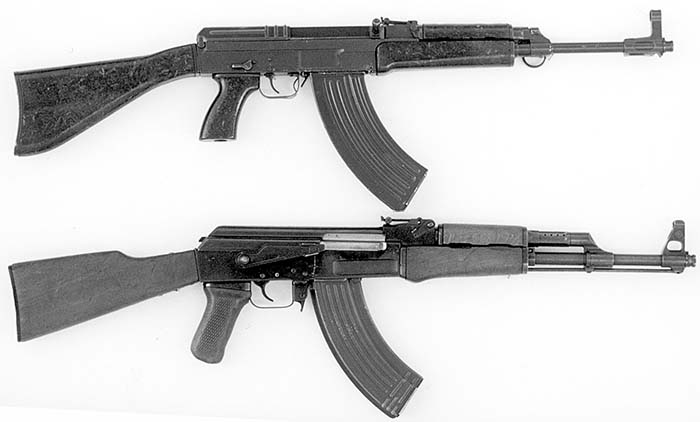
The vz58 appeared in two basic variations, the fixed-stock vz58P and the vz58V equipped with a side-folding metal stock. Except for this distinction, these two models appear to be otherwise identical. In addition to these, there exists a version called as the vz58Pi, which is the basic vz58P except that it has a provision for mounting an infrared night sighting device on the left side of receiver. The vz58Pi also features a light bipod and a conical flash hider attached to the muzzle. During the 1970s, some experiments were reportedly conducted with some 5.45x39mm caliber conversions. None were adopted, and interest turned during the 1980’s to the AK-based LADA small arms family (assault rifle, SMG and LMG) that were originally designed for the Soviet 5.45x39mm M74 round but later modified for the 5.56x45mm NATO cartridge.
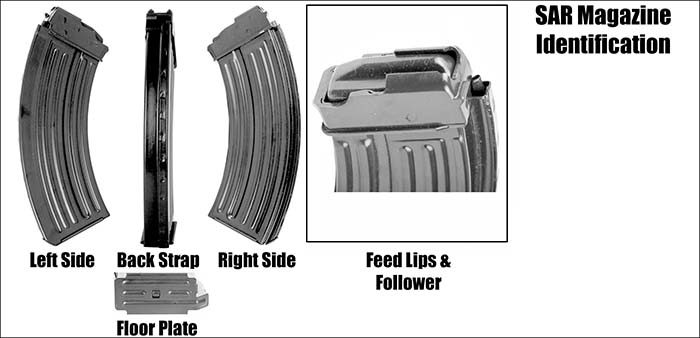
Like most other post-WWII products of the Czechoslovakian small arms industry, the vz58 assault rifle was not widely distributed outside the borders of Czechoslovakia. The vz58 was seldom seen on the news. However, the 7.62x39mm vz58 assault rifles were frequently encountered in Southeast Asia, Africa and the Middle East in the hands of communist-backed forces commencing with the conflict in Viet Nam. Czech vz58 rifles were also issued to certain terrorist groups, including the Palestinian “Black September” movement. After Czechoslovakia was divided into two nations, the Czech and Slovakian republics, respectively, in 1992, vz58 assault rifles, along with a small number of the AK74-type 5.45x39mm rifles stayed in service with the armed forces of both nations.
The vz58 is gas-operated with a short-stroke piston and fires from the closed-bolt position. The gas system has a gas block pattern and location similar to the basic AK/Sturmgewehr design. The piston is placed over the barrel and topped with a sheet steel cover, secured with a single cross pin. The gas system has no regulator or provision for a gas cut-off. The piston is not integral with the bolt carrier. The piston’s maximum travel is 0.6 inches (16 mm), and it has its own return spring to drive it back to its forward position. The piston is chromium plated for better corrosion resistance.
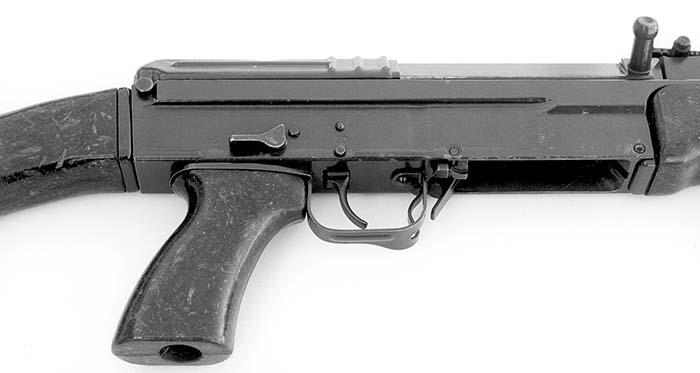
The selector switch is located just above the pistol grip on the right side of the receiver. 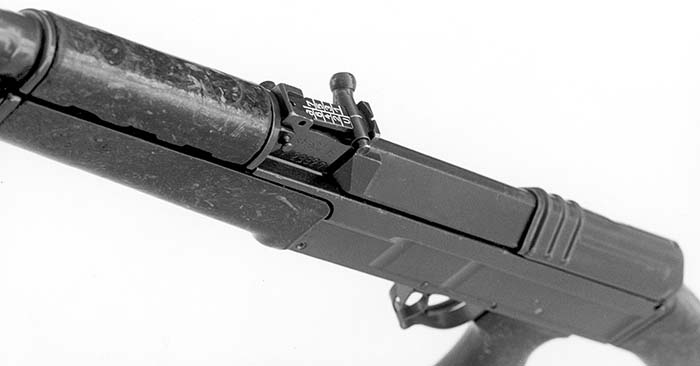
The rear sight is very similar to that used in the AK family of firearms.
Most gas-operated assault rifles have rotating bolt heads with front mounted locking lugs. The vz58’s bolt moves vertically along the bolt carrier’s guide ways. The bolt has a falling locking block with dual locking lugs. Construction is very similar to the Walther P38 or the more recent Beretta 92 except that the locking block operates in the opposite direction, i.e., the locking block drops into the battery. When driven backwards by the gas piston, the bolt carrier withdraws 0.67 inches (17 mm) until the locking piece disengages from the receiver and then moves a further 0.12 inches (3 mm) until bolt engages the bolt carrier follows its rearward motion. As the bolt has no rotating head, there is no primary extraction. The bolt body has a recessed breech face and a single claw-type extractor. The firing pin is of the floating-type as used with most military rifles. The bolt carrier was milled from solid steel bar stock and has complex shape, including bolt guide ways and clearances for allowing the vertical movements of the pivoting locking piece. It should be noted here that the vz58 could be assembled and fired without the locking piece, with disastrous results.

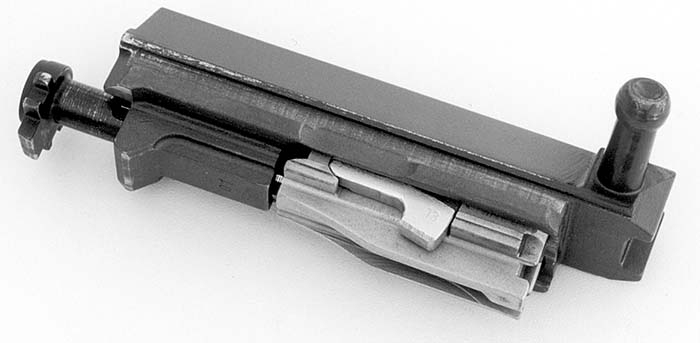
In a manner similar to the SKS carbine or Czech vz52 and vz52/57 rifles, there is a stripper clip guide milled on the front face of the bolt carrier. The 30-round magazine is, however, detachable. Although the vz58 magazine is similar to the AK pattern, it is not interchangeable. The vz58 magazine is stamped from sheet aluminum with ribbed sides. The magazine catch/release is of the AK-type, but smaller of size and can be accessed easily from the left side only.
The magazine follower incorporates a stud that activates the bolt’s hold-open device after the last shot is fired. The small-sized operating button of the hold-open device is located at the front of trigger guard and it can be used to leave the bolt group in the retracted position. There is no manual latch for releasing the retracted bolt and this is accomplished by removing the empty magazine or by inserting a loaded one and pulling back slightly and then releasing the cocking handle. The cocking handle is integral with the piston slide and positioned obliquely upwards.
There is no conventional rotating hammer on the vz58, but its striker-type hammer is a horizontally moving hollow steel bar, which is powered by its own spring assembly that is integral with the receiver’s top cover. The hammer passes through the bolt carrier to the base of the bolt where firing pin is located. Due to its configuration the selective-fire trigger mechanism is different from the majority of designs used with most small arms. In fact, just such a mechanism is encountered on the Swedish Bofors L/60 automatic cannon. The vz58 trigger mechanism can be described as a scaled-down version of design used with the Bofors automatic cannons. The 40 mm Bofors automatic cannon, introduced in 1929, was the first successful automatic cannon design.
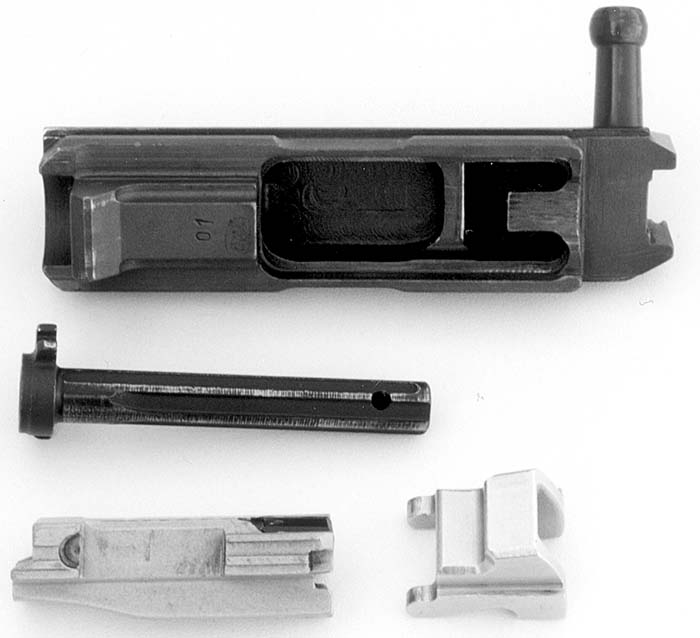
There are two separate sears, side by side, for single-shot and full-auto fire. The full-auto sear is located 1.5 mm behind the single-shot sear. The single-shot sear is fitted with a disconnector that controls the bolt carrier’s movement and when the trigger is pulled the disconnector breaks the trigger connection to the semiauto sear until the trigger is released. When set on the full-auto mode, the disconnector is disengaged and the semiauto sear is connected rigidly to the trigger and held down as long as trigger is pulled. The full-auto sear has a separate trip arm that controls the full-auto sear when the trigger is pulled and holds down the semiauto sear. The fire selector is located just above the pistol grip, on the right side of weapon. The middle position is safe and when the selector is rotated forward, the rifle provides single shots. If rotated backwards, full- auto fire results. The selector markings are “1” and “30,” respectively.
If there is a single component that resembles the AK47, it’s the receiver. The receiver is milled from solid steel, but smaller than the AK. The vz58 is also shorter than the AK-47 or AKM. The receiver has a stamped sheet-metal steel top cover that overlays the rear half of the receiver. The receiver cover includes both the recoil spring and hammer spring that are secured by a single cross pin.
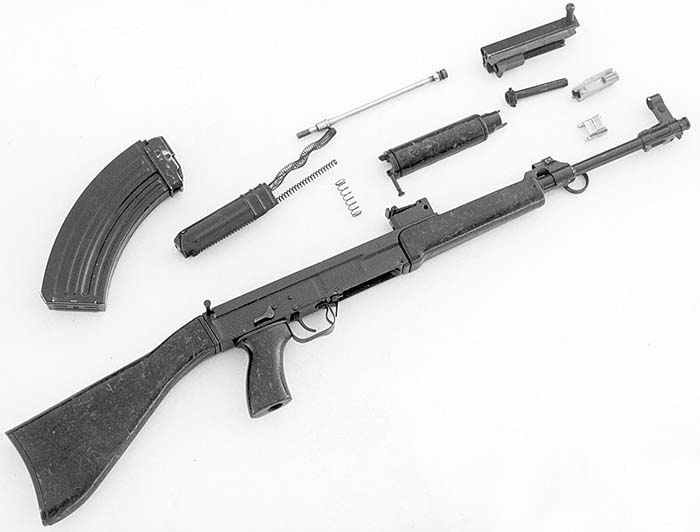
The relatively light barrel has an overall length of 400 mm. The bore has four-groove rifling with a right-hand twist of one turn in 9.45 inches (240 mm). Like most other military rifles and machine guns of Warsaw Pact origin, the bore and chamber are hard chrome plated for better corrosion resistance against powder and primer residues, to withstand the over heating produced by full-auto fire and also to inhibit accelerated wear from firing steel-jacketed ammo. The vz58 has a right-handed muzzle thread to accept a blank firing device or flash hider. It is not compatible to the Kalashnikov muzzle devices. In addition, the bayonet is different from AKM wire-cutter types. The bayonet attaches to a longitudinal rail under the barrel, and slides forward in a unique mounting manner. This bayonet rail also accepts a light bipod with non-adjustable legs.
The earliest examples of the vz58 had wooden stocks, but most vz58s will be encountered with furniture made from red Bakelite reinforced with wood fiber. Sources also report that some recently built rifles were fitted with black plastic furniture. The main difference between the vz58 basic variations is the type of buttstock, as mentioned previously. The vz58P has a fixed, partially hollow Bakelite stock with a steel buttplate, while the vz58V has an L-shaped side folding stock made from steel wire. The vz58 buttstock has a shorter length-of-pull than that found on the most of the AK series. Unlike the Kalashnikov design, the vz 58 buttstock provides no provision for storing cleaning kit. Neither is a cleaning rod is furnished with rifle.
Both the forearm and handguard are quite similar in configuration to those of the Kalashnikov. However, unlike the AK models, the vz58 forearm is riveted in place and cannot be removed without tools. The top handguard is mounted on the gas piston cover. The pistol grip is small and has a shape reminiscent of the late models of the Fallschirmjagergewehr 42. Neither the forearm nor pistol grip are checkered. They both have a glossy, and quite slippery, surface. The rear sling swivel is mounted on the left side of buttstock and the front swivel is attached to the gas block.
Czech vz58 rifles can be found with either a manganese phosphate (Parkerized) or baked gray enamel finish. Our test and evaluation specimen was marked “she 75” and had the latter type of finish.
The vz58 has a set of iron sights very similar to those of the Kalashnikov assault rifles. The front sight is a square post protected by a substantial hood. The front sight is adjustable for both elevation and windage by means of special tools. The rear sight is an open U-notch mounted on a sliding tangent-type base. It is adjustable for elevation only, from 100 meters to 800 meters with 100-meter increments and a 350-meter battle-sight setting. The sight radius is 13.94 inches (354 mm).
There is no provision for mounting auxiliary sighting devices on either the P or V versions of the vz58. The much rarer vz58Pi has an optical sight mounting bracket on the left side of the receiver for Russian NSP infra-red night vision device and the more recent Russian passive night vision devices, including the 1PN58 and 1PN51.
Firing and Handling Characteristics
The vz58 is shorter, thinner and lighter than the AK47 or AKM. The vz58 weighs 1.5 pounds less than the AKM and 2.5 pounds less than the AK47. It is also about 2 inches shorter than the AK47 and AKM assault rifles. The vz58 is easy to carry and feels more like a pistol-caliber submachine gun than a 7.62x39mm caliber assault rifle.
Yes, It’s light, compact and handy, but these qualities bring disadvantages. The vz58 is not very easy to operate with winter mittens; both the selector switch and magazine catch/release are difficult to manipulate if gloves are used. In addition, during prolonged firing sessions some insulation for the forearm is required. If a substantial number of rounds are fired, the vz58 gets so hot that it cannot be comfortably supported with the bare hand. The slim Bakelite handguard provides limited heat insulation and the lightweight barreled action won’t absorb much heat either.
The vz 58 was test fired with three types of the 7.62x39mm M43 caliber ammunition including Chinese Norinco 123-grain FMJ (Full Metal Jacket), Czech 123-grain FMJ sold under the brand name “KOPP” and Finnish Lapua 123-grain FMJ. When fired from the bench at a range of 100 meters, the vz58 was capable of generating 4 to 5 MOA groups with steel-cased Chinese and Czech ammo and 3 to 4 MOA groups with Lapua ammunition. Accuracy is close to average AK-grade, perhaps slightly better.
Strangely, the short stroke, piston-operated vz58 has lower perceived recoil than heavier Kalashnikov rifles. During the test firing sequence, the vz58 operated flawlessly with steel-cased ammunition, but produced continual extraction and feeding malfunction when brass-cased ammunition was cycled through the rifle. Evidently, steel cases are harder and will not adhere to the chamber walls as firmly as brass cases, which require more extraction momentum.
The vz58 expels empty cases about two meters (7 feet) to right. The ejection path is neither as violent as that of the AK series nor are the cases damaged, although this latter is of little concern to a military user.
Although finely made, the vz58 is poorly finished. It is pleasant to handle and fire, if only steel-cased ammunition is employed. Operators prefer what they are programmed to use. I am used to firing and handling the Finnish variant of the AK47, which I still think is better than the vz58. While the Czech rifle is more accurate, the AK is easier to shoot and deploy with and, most important, substantially more reliable.
US LE, Dealers and collectors Notes:
Class Three Supply (724-962-1890) has been importing Post 86 dealer sample restricted vz58s for law enforcement and Class 3 Dealers. Prices are reasonable- in the $400 range, and the quality of the guns I have seen has been excellent. Sarco (908-647-3800) has been selling parts kits, and bayonets have been relatively easy to find on the market, at about $40 each. The leather mag pouches that hold 4 magazines have been on the market recently as well, I bought a set at Knob Creek. There are 4 known transferable vz58s in the United States. There may be more, but I have never seen them. There were three full stock and one folder. One set was sold as full stock and folder, and these two were Vietnam bringbacks, registered in that time period. The finish on all of the transferables that I have seen was of the grey paint, and the stocks were all red bakelite style
| This article first appeared in Small Arms Review V4N10 (July 2001) |









